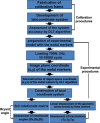A biomechanical evaluation of proximal femoral nail antirotation with respect to helical blade position in femoral head: A cadaveric study
- PMID: 23325963
- PMCID: PMC3543878
- DOI: 10.4103/0019-5413.104186
A biomechanical evaluation of proximal femoral nail antirotation with respect to helical blade position in femoral head: A cadaveric study
Abstract
Objective: Despite new developments in the management of osteoporotic fractures, complications like screw cutout are still found in the fixation of proximal femur fractures even with biomechanically proven better implants like proximal femoral nail antirotation (PFNA). The purpose of this cadaveric study was to investigate the biomechanical stability of this device in relation to two common positions (center-center and inferior-center) of the helical blade in the femoral head in unstable trochanteric fractures.
Materials and methods: Eight pairs of human cadaveric femurs were used; in one group [center-center (C-C) group], the helical blade of PFNA was fixed randomly in central position both in anteroposterior and lateral view, whereas in the other group it was fixed in inferior one-third position in anteroposterior and in central position in lateral view [inferior-center (I-C) group]. Unstable intertrochanteric fracture was created and each specimen was loaded cyclically till load to failure
Results: Angular and rotational displacements were significantly higher within the C-C group compared to the I-C group in both unloaded and loaded condition. Loading to failure was higher in the I-C group compared to the C-C group. No statistical significance was found for this parameter. Correlations between tip apex distance, cyclic loading which lead to femoral head displacement, and ultimate load to failure showed a significant positive relationship.
Conclusion: The I-C group was superior to the C-C group and provided better biomechanical stability for angular and rotational displacement. This study would be a stimulus for further experimental studies with larger number specimens and complex loading protocols at multicentres.
Keywords: Biomechanical study; PFNA; cadaveric study; helical blade position; unstable trochanteric fracture.
Conflict of interest statement
Figures




Similar articles
-
Helical blade versus sliding hip screw for treatment of unstable intertrochanteric hip fractures: a biomechanical evaluation.Injury. 2006 Oct;37(10):984-9. doi: 10.1016/j.injury.2006.06.008. Epub 2006 Aug 24. Injury. 2006. PMID: 16934256
-
Biomechanical Comparison of Three Different Intramedullary Nails for Fixation of Unstable Basicervical Intertrochanteric Fractures of the Proximal Femur: Experimental Studies.Biomed Res Int. 2018 Dec 11;2018:7618079. doi: 10.1155/2018/7618079. eCollection 2018. Biomed Res Int. 2018. PMID: 30643821 Free PMC article.
-
An unusual case of femoral head perforation following fixation with proximal femoral nail antirotation (PFNA-II) for an unstable intertrochanteric fracture: Case report and literature review.Trauma Case Rep. 2019 Feb 11;20:100178. doi: 10.1016/j.tcr.2019.100178. eCollection 2019 Apr. Trauma Case Rep. 2019. PMID: 30805427 Free PMC article.
-
Rotationally Stable Screw-Anchor With Locked Trochanteric Stabilizing Plate Versus Proximal Femoral Nail Antirotation in the Treatment of AO/OTA 31A2.2 Fracture: A Biomechanical Evaluation.J Orthop Trauma. 2016 Jan;30(1):e12-8. doi: 10.1097/BOT.0000000000000422. J Orthop Trauma. 2016. PMID: 26849388
-
Acetabular perforation after medial migration of the helical blade through the femoral head after treatment of an unstable trochanteric fracture with proximal femoral nail antirotation (PFNA): a case report.J Orthop Trauma. 2011 Sep;25(9):e86-9. doi: 10.1097/BOT.0b013e3181fae12e. J Orthop Trauma. 2011. PMID: 21577153
Cited by
-
The Effect of Intraoperative Patient Positioning on the Success of Intertrochanteric Fracture Surgery in Older Patients.Medicina (Kaunas). 2024 Apr 18;60(4):646. doi: 10.3390/medicina60040646. Medicina (Kaunas). 2024. PMID: 38674292 Free PMC article.
-
Biomechanical comparison of the femoral neck system and the dynamic hip screw in basicervical femoral neck fractures.Sci Rep. 2022 May 12;12(1):7915. doi: 10.1038/s41598-022-11914-1. Sci Rep. 2022. PMID: 35551221 Free PMC article.
-
A biomechanical evaluation of proximal femoral nail antirotation with respect to helical blade position in femoral head: A cadaveric study.Indian J Orthop. 2014 May;48(3):343. doi: 10.4103/0019-5413.132537. Indian J Orthop. 2014. PMID: 24932047 Free PMC article. No abstract available.
-
Proximal Femoral Nail Antirotation in Treatment of Intertrochanteric Hip Fractures: a Retrospective Study in 113 Patients.Med Arch. 2015 Dec;69(6):352-6. doi: 10.5455/medarh.2015.69.353-356. Med Arch. 2015. PMID: 26843723 Free PMC article.
-
Conventional versus helical blade screw insertion following the removal of the femoral head screw: a biomechanical evaluation using trochanteric gamma 3 locking nail versus PFN antirotation.BMC Musculoskelet Disord. 2021 Sep 8;22(1):767. doi: 10.1186/s12891-021-04658-y. BMC Musculoskelet Disord. 2021. PMID: 34496801 Free PMC article.
References
-
- Burge R, Dawson-Hughes B, Solomon DH, Wong JB, King A, Tosteson A. Incidence and economic burden of osteoporosis-related fractures in the United States, 2005-2025. J Bone Miner Res. 2007;22:465–75. - PubMed
-
- Penzkofer J, Mendel T, Bauer C, Brehme K. Treatment results of pertrochanteric and subtrochanteric femoral fractures: A retrospective comparison of PFN and PFNA. Unfallchirurg. 2009;112:699–705. - PubMed
-
- Mahomed N, Harrington I, Kellam J, Maistrelli G, Hearn T, Vroemen J. Biomechanical analysis of the Gamma nail and sliding hip screw. Clin Orthop Relat Res. 1994;304:280–8. - PubMed
-
- Kold S, Bechtold JE, Mouzin O, Elmengaard B, Chen X, Soballe K. Fixation of revision implants is improved by a surgical technique to crack the sclerotic bone rim. Clin Orthop Relat Res. 2005;432:160–6. - PubMed
-
- Mereddy P, Kamath S, Ramakrishnan M, Malik H, Donnachie N. The AO/ASIF proximal femoral nail antirotation (PFNA): A new design for the treatment of unstable proximal femoral fractures. Injury. 2009;40:428–32. - PubMed
LinkOut - more resources
Full Text Sources
Miscellaneous
